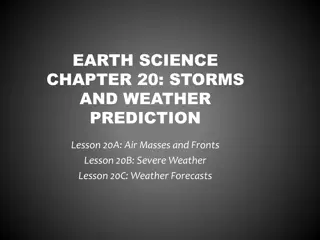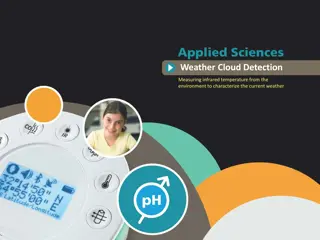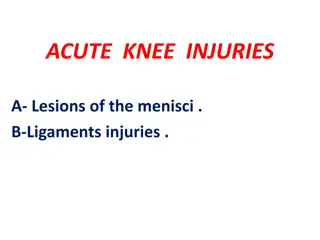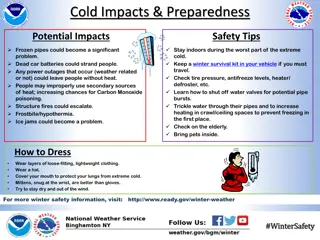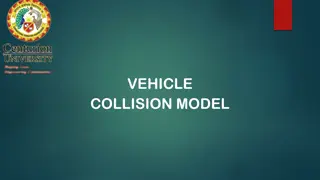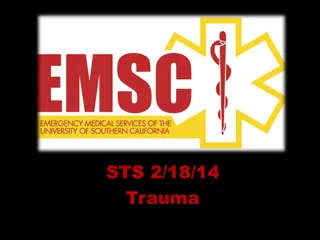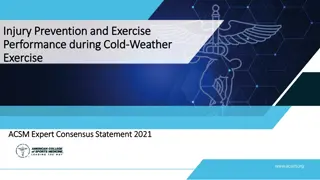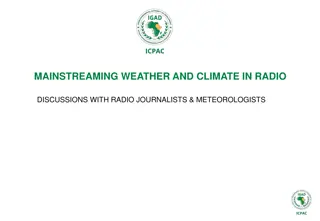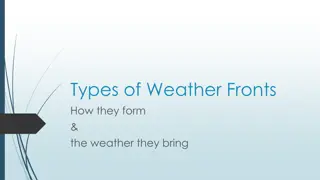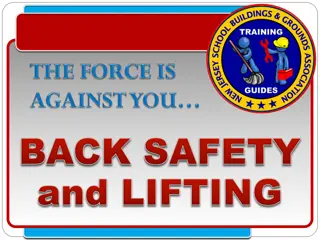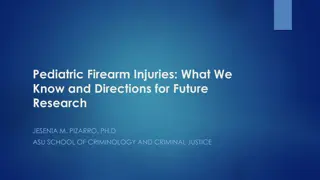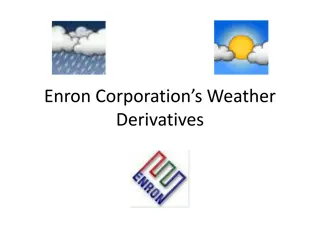Cold Weather Injuries Prevention Training
This slide deck focuses on preventing, identifying, and treating cold weather injuries. It emphasizes the responsibility of both individuals and commands in preventing cold injuries, highlighting factors contributing to susceptibility and methods for regulation body temperature in cold environments.
Download Presentation

Please find below an Image/Link to download the presentation.
The content on the website is provided AS IS for your information and personal use only. It may not be sold, licensed, or shared on other websites without obtaining consent from the author.If you encounter any issues during the download, it is possible that the publisher has removed the file from their server.
You are allowed to download the files provided on this website for personal or commercial use, subject to the condition that they are used lawfully. All files are the property of their respective owners.
The content on the website is provided AS IS for your information and personal use only. It may not be sold, licensed, or shared on other websites without obtaining consent from the author.
E N D
Presentation Transcript
Slide Set for Unit/Installation Training Applications* Cold Weather Injuries: Prevention, Identification, and Treatment * This slide deck was prepared for adaption and local use by units/installation personnel when conducting cold injury prevention training. The information presented in these slides and notes sections (as posted) has been approved by the Disease Epidemiology Program (DEP) of the U.S. Army Public Health Center (APHC) asof February 2019. The DEP can be contacted at 410-436-9286 for technical consultation regarding cold injury prevention. The requirement for Army Cold Weather Injury Prevention training is established by the Army Medical Command the current (2013) policy memorandum is at https://www.us.army.mil/suite/doc/41860392. This presentation material includes images from Defense Imagery Management Operations Center, https://www.dimoc.mil/ and slides from U.S. Army Safety Center, https://safety.army.mil/ Additional information links and resources may be obtained from APHC at: https://phc.amedd.army.mil/topics/discond/cip/Pages/Cold-Weather-Casualties-and-Injuries.aspx UNCLASSIFIED 1
Cold Weather Injuries: Prevention, Identification, and Treatment Presenter s Name Presenter s Command Local Contact Information insert date UNCLASSIFIED 2
Introduction Prevention of cold injuries is a Command and Individual Responsibility ALL COLD WEATHER INJURIES ARE PREVENTABLE!!! UNCLASSIFIED 3
Outline Susceptibility Factors Cold Weather Injuries Description Identification Treatment Prevention Conclusion UNCLASSIFIED 4
Typical Victim of a Cold Weather Injury Male E-4 or below Around 20 years old From a warm climate Less than 18 months time in service Uses tobacco, alcohol, and/or medications Neglects proper foot care However, ANYONE can become a cold weather casualty! UNCLASSIFIED 5
Susceptibility Factors Previous cold weather injury Inadequate nutrition Alcohol or nicotine use Dehydration Over-activity Under-activity Long exposure to the cold Sick or injured Ethnic/geographic origin Wind, cold, rain Age Discipline and morale Physical stamina Inadequate training Poor clothing and equipment UNCLASSIFIED 6
Body Temperature Regulation Heat Production Metabolism Exercise Shivering Heat Loss Convection Conduction Radiation Evaporation Respiration When heat loss and production are in balance, body temperature is stable When heat loss is greater, either in an area of the body (finger, toes) or in the body core, cooling occurs When cooling is too great, cold weather injury can occur UNCLASSIFIED 7
Types of Cold Injuries Hypothermia Frostbite Non-freezing cold injuries Chilblains Immersion/Trench Foot Injuries related to cold exposure Dehydration Sunburn Snow Blindness Carbon Monoxide Poisoning UNCLASSIFIED 8
Hypothermia MEDICAL EMERGENCY; life threatening condition Severe body heat loss-body temp falls below 95oF Occurs when: cold conditions are severe conditions are windy, clothing is wet, and/or the individual is inactive extended water exposure or immersion 1 hour or less when water temp is below 45oF prolonged exposure in slightly cool water (e.g. 60oF) thunderstorms, hail, rain and accompanying winds UNCLASSIFIED 9
The umbles- stumbles, mumbles, fumbles, and grumbles Hypothermia Initial Symptoms shivering dizzy, drowsy withdrawn behavior irritability confusion slowed, slurred speech altered vision stumbling Severe Stages stops shivering desire to lie down and sleep heartbeat and breathing are faint or undetectable unconsciousness followed by DEATH UNCLASSIFIED 10
Hypothermia Treatment prevent further cold exposure evacuate immediately if severe hypothermia remove wet clothing rewarm with body-to-body contact or in a warmed sleeping bag warm, sweet liquids if conscious give CPR if needed UNCLASSIFIED 11
Hypothermia Prevention wear uniform properly (layers worn loosely) stay dry keep active eat properly and often warm liquids and water warming tents get plenty of rest buddy watch/observation/NCO checks UNCLASSIFIED 12
Hypothermia Symptoms OBSERVABLE IN OTHERS Slowing of pace. Intense shivering. Poor coordination. BODY TEMP SYMPTOMS FELT BY YOURSELF (Early Stage) 98.6 95.0 Intense and uncontrollable shivering; ability to perform complex tasks impaired. Fatigue. Uncontrollable fits of shivering. Immobile, fumbling hands. Stumbling. Poor articulation. Feeling of deep cold or numbness. Disorientation. Decrease in shivering. Stiffening of muscles. Exhaustion, inability to get up after a rest. Blueness of skin. Slow, irregular, or weak pulse. Drowsiness. (Moderate Stage) 95.0 91.4 Violent shivering persists, difficulty in speaking, sluggish thinking, amnesia begins to appear. Shivering decreases; replaced by muscular rigidity and erratic, jerky movements; thinking not clear but maintains posture. Stumbling, lunching gait. Thickness of speech. Poor judgment. Irrationality, incoherence. Memory lapses, amnesia. Hallucinations. Loss of contact with environment. (Severe Stages) 91.4 87.8 87.8 85.2 Victim becomes irrational, loses contact with environment, drifts into stupor; muscular rigidity continues; pulse and respiration slowed. Blueness of skin. Decreased heart and respiratory rate. Dilation of pupils. Weak or irregular pulse. Stupor. Unconsciousness. 85.2 78.8 Unconsciousness; does not respond to spoken words; most reflexes cease to function; heartbeat becomes erratic. Failure of cardiac and respiratory control centers in brain; cardiac fibrillation; probable edema and hemorrhage in lungs; apparent death. 78.8 UNCLASSIFIED 13
Frostbite Air temps below 32oF skin freezes at 28oF Superficial frostbite (mild) freezing of skin surface Deep frostbite (severe) freezing of skin and flesh, may include bone Hands, fingers, feet, toes, ears, chin, nose, groin area UNCLASSIFIED 14
Frostbite Symptoms initially redness in light skin or grayish in dark skin tingling, stinging sensation turns numb, yellowish, waxy or gray color feels cold, stiff, woody blisters may develop UNCLASSIFIED 15
Frostbite Treatment remove from cold and prevent further heat loss remove constricting clothing and jewelry rewarm affected area evenly with body heat until pain returns when skin thaws it hurts!! do not rewarm a frostbite injury if it could refreeze during evacuation or if victim must walk for medical treatment do not massage affected parts or rub with snow evacuate for medical treatment UNCLASSIFIED 16
Frostbite Prevention wear uniform properly (layers and loosely) keep socks and clothing dry (use poly pro/thermax liner socks and foot powder/ change insoles also) protect yourself from wind drink hot fluids and eat often keep active insulate yourself from the ground (sleeping pad/tree branches, etc.) Buddy System warm with body heat avoid skin contact with super-cooled metals or fuel seek medical aid for all suspected cases UNCLASSIFIED 17
Chilblains Nonfreezing cold injury Cold, wet conditions (between 32-60oF, high humidity) Repeated, prolonged exposure of bare skin Can develop in only a few hours Ears, nose, cheeks, fingers, and toes UNCLASSIFIED 18
Chilblains Symptoms: initially pale and colorless worsens to achy, prickly sensation then numbness red, swollen, hot, itchy, tender skin upon rewarming blistering in severe cases UNCLASSIFIED 19
Chilblains Treatment prevent further exposure wash, dry gently rewarm (apply body heat) don t massage or rub dry sterile dressing seek medical aid UNCLASSIFIED 20
Chilblains Prevention keep dry and warm cover exposed skin wear uniform properly use the Buddy System UNCLASSIFIED 21
Trench/Immersion Foot Potentially crippling, nonfreezing injury (temps from 32oF- 50oF) Prolonged exposure of skin to moisture (12 or more hours, days) High risk during wet weather, in wet areas, or when sweat accumulates in boots or gloves UNCLASSIFIED 22
Trench/Immersion Foot Symptoms initially appears wet, soggy, white, shriveled sensations of pins and needles, tingling, numbness, and then pain skin discoloration-red, bluish, or black becomes cold, swollen, and waxy in appearance may develop blisters, open weeping, or bleeding in extreme cases, flesh dies UNCLASSIFIED 23
Trench/Immersion Foot Treatment prevent further exposure dry carefully DO NOT break blisters, apply lotions, massage, expose to heat, or allow to walk on injury rewarm with body heat clean and wrap loosely elevate feet to reduce swelling evacuate for medical treatment UNCLASSIFIED 24
Trench/Immersion Foot Prevention keep feet dry change socks and apply foot powder at least every 8 hours or whenever wet bring extra boots to field no blousing bands report all suspected cases to leadership UNCLASSIFIED 25
Dehydration A condition caused by the excessive loss of water from the body May increase the risk of hypothermia due to impaired ability to keep active and generate body heat UNCLASSIFIED 26
Dehydration Symptoms dark urine headache dizziness, nausea weakness dry mouth, tongue, throat, lips lack of appetite stomach cramps or vomiting irritability decreased amount of urine being produced mental sluggishness increased or rapid heartbeat lethargy UNCLASSIFIED 27
Dehydration Treatment drink WATER or other warm liquids do not eat snow rest UNCLASSIFIED 28
Dehydration Prevention drink minimum of 3 canteens of water daily if inactive and 5-6 quarts if active monitor urine color do not wait until you are thirsty drink hot liquids for warmth UNCLASSIFIED 29
Sunburn Burning of the skin due to overexposure to the sun and UV light Contributing factors fair skin, light hair exposed skin reflective qualities of the snow high altitudes Symptoms redness of skin, slight swelling (1st degree) prolonged exposure (2nd degree) pain and blistering chills, fever, headache UNCLASSIFIED 30
Sunburn Treatment soothing skin creams in mild cases in severe cases, seek medical attention aspirin for pain Prevention cover exposed skin with clothing sunscreen, lip balm limit exposure of skin to the environment UNCLASSIFIED 31
Carbon Monoxide Poisoning When oxygen in the body is replaced by carbon monoxide colorless, odorless, tasteless gas resulting from incomplete combustion Inadequate ventilation from engines, stoves, heaters UNCLASSIFIED 32
Carbon Monoxide Poisoning Symptoms headache dizziness weakness excessive yawning ringing in ears confusion nausea bright red lips, eyelids drowsiness unconsciousness possibly death UNCLASSIFIED 33
Carbon Monoxide Poisoning Treatment move to fresh air immediately seek medical aid promptly provide mouth-to-mouth resuscitation if victim is not breathing UNCLASSIFIED 34
Carbon Monoxide Poisoning Prevention ensure proper ventilation don t use unvented heaters or engines ensure heaters are regularly serviced turn heaters off when not needed (during sleep) never sleep in vehicle with engine running never wrap poncho around vehicle exhaust to collect heat UNCLASSIFIED 35
Snow Blindness Inflammation and sensitivity of the eyes caused by ultraviolet rays of the sun reflected by the snow or ice Symptoms gritty feeling in eyes redness and tearing eye movement will cause pain headache UNCLASSIFIED 36
Snow Blindness Treatment remove from sunlight blindfold both eyes or cover with cool, wet bandages seek medical attention recovery may take 2-3 days Prevention eye protection dark, UV protective glasses field expedient-cut narrow slits in MRE cardboard and tie around head do not wait for discomfort to begin UNCLASSIFIED 37
Conclusion Dress properly Drink plenty of fluids Eat right Keep in shape Get plenty of rest Minimize periods of inactivity Maintain a positive attitude UNCLASSIFIED 38
References and Resources TB MED 508 Prevention and Management of Cold Weather Injuries TC 21-3 Soldier s Handbook for Individual Operations and Survival in Cold-Weather Areas FM 21-10 Field Hygiene and Sanitation FM 4-25.11 First Aid U.S. Army Public Health Center Cold Weather Injury Prevention webpage: https://phc.amedd.army.mil/topics/discond/cip/Pages/Cold- Weather-Casualties-and-Injuries.aspx U.S. Army Research Institute of Environmental Medicine Guidance downloads: http://www.usariem.army.mil/index.cfm/publications/guidance UNCLASSIFIED 39
References and Resources Individuals interested in heat illness and CWI on-line training that produces a certificate: Central Army Registry (CAR) Virtual Mission Preparation Course (Hot/Cold Weather Injury) Go to: https://rdl.train.army.mil Log in with CAC In the Search the CAR field in the upper left, paste 553G D01 Virtual Mission Preparation Course (Hot/Cold Weather Injury Prevention) Click on the blue hyperlink EAMS-A may be required, which should lead to a page describing the training Scroll down and click on the View button at the bottom UNCLASSIFIED 40
Questions? UNCLASSIFIED 41







